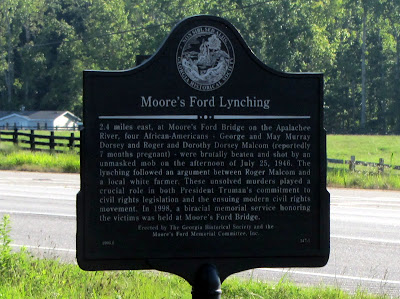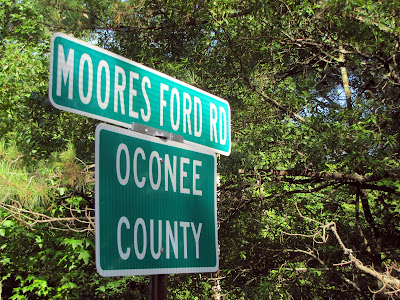Part I (Background)
65 years ago, as of the publishing of this post, a terrible event occurred in the vicinity of the place where we all live. When you hear of tragic events like this, a part of your mind thinks, maybe wishes, that it is only a thing of the past to be forgotten like the Horse & Buggy or the 8-track tape. But there is a danger in forgetting too much history, especially the parts that make us nervous or queasy. My attempt to alleviate the perils of history forgotten will stand with the GABEO, and there presentation of the events surround the last mass lynching in the United States, or what is most commonly referred to as the Moore’s Ford Lynching.

The Dark event occurred on July 26, 1946 (Time Article). Not so long ago that there aren’t people still alive who remember the event. Four black people, George & Mae Murray Dorsey and Roger & Dorothy Malcom, were taken from a car at the bridge across the Appalachee River at the Walton-Oconee County Line, where they were repeatedly shot, some reports say 60+ shots were fired, ending their young lives. There is much more to the story: It came during a period when the idea of lynching a black person was something society knew was a practice, especially in the South. It came at a time prior to the rise of Civil Rights leaders such a Martin Luther King, and any real semblance of equal citizenship for black Americans. This was the way things were done in that period of American History, as ugly as it may be, we do ourselves great harm if we look away.

The Georgia Association of Black Elected Officials (or GABEO) feels the same way. And for the past several years they have held a commemorationof the event of that dark July night. This year is was this past Saturday, July 23rd. The first purpose is to keep this unsolved case from seeping out of our collective memories. The second purpose is that it stands to reason that somebody who lives in the area may have information that could bring the perpetrators of the murder to justice.

The Day began with a rally at the First African Baptist Church of Monroe at Noon. I can attest by my present that all were welcome to attend this event. It gave the organizers about two hours to get everyone together to make the trip around Monroe. During this time, Black elected leaders, community leaders, and religious leaders spoke to edify and amplify the attendees. There was also a fair amount of music and an introduction of the actors.

The first scene was done at the church. The players were Barnette Hester, Roger Malcom and Dorothy Malcom. Apparently, Barnette had made some disparaging comments about the propriety of Dorothy Malcom, and Roger aimed to do something about it. Roger confronted Barnette and a scuffle ensued. In the melee Roger stabbed Barnette and then fled. The historical versions of this event say that Barnette was armed with a pitchfork, and that it may have been sexual advances or even actions toward Dorothy that raised Roger’s ire. Any way you slice it, it was not a good time in history for a black man to stab a white man. Roger ended up caught and imprisoned for 11 days. In the past this part of the reenactment was held in front of Barnette Hester’s house at 2932 Hester Town Road. But due to logistics, and some trepidation, they decided to do this part at the church.
Click here to continue to PART TWO
| From Moore's Ford Lynching |
65 years ago, as of the publishing of this post, a terrible event occurred in the vicinity of the place where we all live. When you hear of tragic events like this, a part of your mind thinks, maybe wishes, that it is only a thing of the past to be forgotten like the Horse & Buggy or the 8-track tape. But there is a danger in forgetting too much history, especially the parts that make us nervous or queasy. My attempt to alleviate the perils of history forgotten will stand with the GABEO, and there presentation of the events surround the last mass lynching in the United States, or what is most commonly referred to as the Moore’s Ford Lynching.
The Dark event occurred on July 26, 1946 (Time Article). Not so long ago that there aren’t people still alive who remember the event. Four black people, George & Mae Murray Dorsey and Roger & Dorothy Malcom, were taken from a car at the bridge across the Appalachee River at the Walton-Oconee County Line, where they were repeatedly shot, some reports say 60+ shots were fired, ending their young lives. There is much more to the story: It came during a period when the idea of lynching a black person was something society knew was a practice, especially in the South. It came at a time prior to the rise of Civil Rights leaders such a Martin Luther King, and any real semblance of equal citizenship for black Americans. This was the way things were done in that period of American History, as ugly as it may be, we do ourselves great harm if we look away.
The Georgia Association of Black Elected Officials (or GABEO) feels the same way. And for the past several years they have held a commemorationof the event of that dark July night. This year is was this past Saturday, July 23rd. The first purpose is to keep this unsolved case from seeping out of our collective memories. The second purpose is that it stands to reason that somebody who lives in the area may have information that could bring the perpetrators of the murder to justice.

The Day began with a rally at the First African Baptist Church of Monroe at Noon. I can attest by my present that all were welcome to attend this event. It gave the organizers about two hours to get everyone together to make the trip around Monroe. During this time, Black elected leaders, community leaders, and religious leaders spoke to edify and amplify the attendees. There was also a fair amount of music and an introduction of the actors.
The first scene was done at the church. The players were Barnette Hester, Roger Malcom and Dorothy Malcom. Apparently, Barnette had made some disparaging comments about the propriety of Dorothy Malcom, and Roger aimed to do something about it. Roger confronted Barnette and a scuffle ensued. In the melee Roger stabbed Barnette and then fled. The historical versions of this event say that Barnette was armed with a pitchfork, and that it may have been sexual advances or even actions toward Dorothy that raised Roger’s ire. Any way you slice it, it was not a good time in history for a black man to stab a white man. Roger ended up caught and imprisoned for 11 days. In the past this part of the reenactment was held in front of Barnette Hester’s house at 2932 Hester Town Road. But due to logistics, and some trepidation, they decided to do this part at the church.
Click here to continue to PART TWO
No comments:
Post a Comment